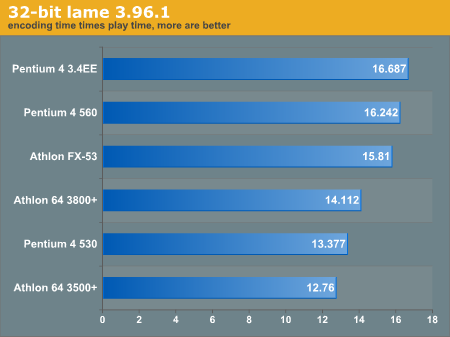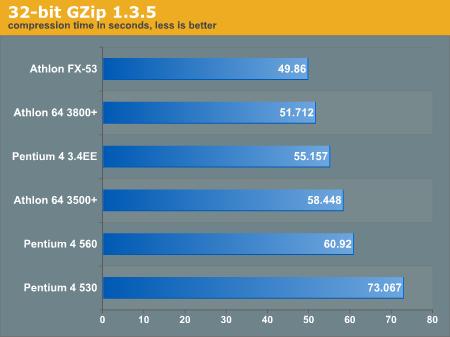Linux Desktop CPU Roundup: Cutting Edge Penguin Performance
by Kristopher Kubicki on September 19, 2004 8:00 PM EST- Posted in
- Linux
Content Creation
On the other end of Synthetic Benchmarks, we have content creation benchmarks, which are extremely difficult to replicate and convey little information if interpreted incorrectly. Below, we compiled lame 3.96.1 without any additional optimizations and then used the following command on a 800mb .wav file.# lame sample.wav -b 192 -m s -h - >/dev/null
The file is sent to stdout, which is then directed to /dev/null. We do not want the hard drive to throttle our MP3 encoding if possible, even if we are just immediately destroying it.
Under the GCC 3.4.1 compiler, we noticed the largest difference between 64-bit and 32-bit binaries yet. The 64-binaries are encoding 25 times faster than if we were to play them, i.e. in one second the Athlon FX-53 encodes ~25 seconds worth of playtime!
Next, we used the SuSE 9.1 Pro i686 RPM for this portion of the analysis. The 700MB test file from the lame benchmark above was compressed and then timed using the command below.
# time gzip -c sample.wav > /dev/null
Now on to our MEncoder test. We compiled 1.0pre5 from source without any optimizations. We had difficulty getting MPlayer to compile on x86_64, and thus, that portion was omitted. The benchmark command that we ran is below:
# time mencoder sample.mpg -nosound -ovc lavc vcodec=mpeg4:vpass=2 -o sample.avi

Again, we saw vast differences between the AMD and Intel processors on these content specific benchmarks.












33 Comments
View All Comments
ravedave - Monday, September 20, 2004 - link
What klah is trying to say in too many and too big of words : Make the scale the same for the mouseover pics.Also make the picture height the same as well if possible.
Otherwise a very good article.
Has anyone thought of making an open office benchmark for linux?
klah - Monday, September 20, 2004 - link
Good article, but I have a comment on the mouse-over graphs. They work well in other articles such as the recent DVR-108D article where the scale and axes remain constant. In this case however the layout and in some cases even the scale are different between the two graphs. It would be easier to compare the two if the scale was the same and processors were in the same layout(spacing/location), with the inapplicable processors still listed to maintain the same appearance between the two.If that explanation is nonsensical I can create a few images to try to elucidate my point.
Decoder - Monday, September 20, 2004 - link
"Hold your mouse over for the 64-bit graph."I like to see the 32 and 64 bits on the same graph. Why not use Athlon FX-53 (32) and Athlon FX-53 (64) for labels?